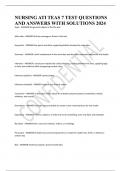Samenvatting
Samenvatting - Adaptive Interactive Systems (INFOMAIS) (INFOMAIS)
- Instelling
- Universiteit Utrecht (UU)
This document contains all information from the lecture slides, additional notes, literature summaries and additional explanations and illustrations (some screenshots from important slides). new terms are highlighted in bold and red and important information is also in bold.
[Meer zien]













